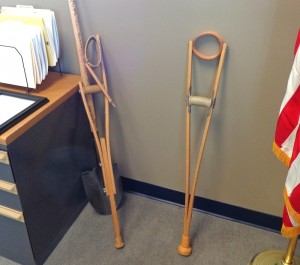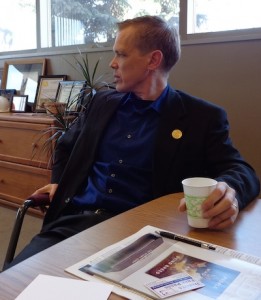Mayor Sam Kooiker has a city and a re-election campaign to run. But he has time to tell a story or two.

Kooiker has two old wooden crutches in his office. He might have a couple more regularly used crutches in his office if it weren’t for Lee Ann Roetman, the owner of the crutch on the right. Roetman worked through her own post-polio disability to help others as an occupational therapist. She worked with Sam when he was a child to help him deal with his cerebral palsy. In 1996, she prepared him for the “life-changing” surgery that gave him the mobility he currently enjoys. Roetman died last year on Easter morning.
The crutch on the left belonged to Kacy DeVries. Sam said he and Kacy met when Kacy whacked him with his crutches while playing soccer in sixth grade. They became friends shortly thereafter.

Kacy died in a car accident in 1993. Sam saw Kacy moments before the crash. Mayor Kooiker now sees Kacy’s broken crutch next to his desk every day, next to Lee’s crutch.
Mayor Kooiker looks over at those mementos of his friends and says the central challenge of governing is developing a focus. “Get the center right,” says Kooiker, “and the circumference takes care of itself.” Kooiker says his focus is to take care of people first.
Now let’s run a city… and learn why Sam Kooiker wants to do it for a third term.
* * *
Running Rapid City means navigating a sharp racial divide between the majority whites and the minority American Indians. Mayor Kooiker approaches race relations cautiously; he says, “my Native friends are very perceptive” and can tell when a politician is pandering to them or dissembling.
Mayor Kooiker says the mayor’s first job in bringing Rapid City’s racial groups together is to listen. He compares the process to research at the Sanford Lab in Lead. No one knows what the answers are at the start. No one knows what interactions will be discovered or new technologies spun off. Everything starts with questions, curiosity, and a commitment to learning.
Beyond that listening, Mayor Kooiker says he has a track record of working to bridge Rapid City’s race gap. He takes credit for fixing in 2011 the previous decade’s gerrymander of the city council boundaries. He says he has revitalized the city Human Relations Commission. Mayor Kooiker says he pushed the city’s disability consideration policy (not ensuring city jobs, but making an extra effort to give disabled applicants interviews) in 2012 in part because he recognizes that the American Indian population is disproportionately affected by disabilities. He says Native outreach includes spending an extra $30K a year to publish the city council minutes in the Native Sun News as well as the Rapid City Journal.
Yet Mayor Kooiker is keenly aware that any number of policy accomplishments and steps toward reconciliation can be wiped out by one bad incident, like the alleged beer-chucking incident at the January 24 Rapid City Rush hockey game. Mayor Kooiker says that to overcome that negative press, the mayor has to continue to make clear to American Indians that they can come talk to the mayor. The mayor must continue to be willing to call out racism. Mayor Kooiker says he wants the city to continue its support for the First Nations Sculpture Garden, which will be built in Halley Park, the green wedge where Main splits to St. Joseph in Rapid. He will also continue to support a city resolution passed last year seeking the return of three parcels of old “Sioux San Campus” and Indian boarding school land in Rapid City to tribal trust status.
* * *
Race relations are one of four planks in the governing agenda Mayor Kooiker is talking up in his campaign for re-election (also mentioned in Kooiker’s video). The other big items are infrastructure upgrades, streamlining, and the Civic Center.
Rapid City’s current big dig is the extension of a water main out toward the airport. That new water line will bring fire protection (Mayor Kooiker says a wastewater treatment plant out east has no functioning fire hydrants and would have to truck water in if there were a fire on the grounds). It will also support economic development, as those big open regions east and south of the city are envisioned as the next loci of residential and business development for Rapid City.
Kooiker says the city is coming at infrastructure with a more scientific approach. For instance, roads are now measured by a “pavement condition index” that better determines when roads require repair. Kooiker says the north and northwest parts of town are also getting a fairer shake. Previously, water and sewer pipes under the streets in those areas were in such bad shape that the city hesitated to roll in to do street projects for fear of triggering huge pipe repairs. Now, says Kooiker, the city does a better job of pooling resources so it can deal with bad pipes at the same time as bad roads.
Kooiker says his efforts to streamline city government have succeeded. He says that when he started as mayor four years ago, Rapid City government had 86 boards, commissions, and committees. With the elimination this week of the zoning board (folded into the planning board, says the Mayor), the city is down to 42 such bodies. Ending the requirement that the mayor approve all bills of $500 or more has reduced the average time it takes the city to pay bills from 70 days to 30 days. Moving approval for various permits, plats, raffles, and licenses from the council level to the department level has freed up the council, in Kooiker’s words, to “fight less and argue more” on policy issues.
The Civic Center continues to take up big space on the council’s policy plate, following Rapid City voters’ firm rejection of the city’s $180 million expansion plan for the facility. Kooiker says he collected more signatures than anyone else to refer that plan to a public vote, and he says that if the city comes forward with another expansion plan, he would support putting that to a public vote, just as the original Barnett Center faced a public vote when Rapid City built it over forty years ago.
As he looks for Plan B, Mayor Kooiker says the public’s rejection of Plan A set the city “back at Square 6, not Square 1.” The March vote indicates that the city must come up with a plan that costs less, addresses ADA issues, expands the Barnett Arena space that the city can market to vendors, and optimally balances the construction schedule with existing events. Kooiker says any renovation or construction simply cannot shut out the major money-making events at the Civic Center, like the Lakota Nation Invitational and the Black Hills Stock Show and Rodeo (Rapid City survives on cowboys and Indians), but he notes that the defeated expansion had a particularly high project because of an extended construction schedule filled with delays to accommodate Civic Center events.
* * *
Race relations, infrastructure, streamlining, and the civic center—those are the four main areas Mayor Kooiker has chosen as the expressions of his central philosophy of taking care of people first. On June 2, Rapid City voters will say at the polls whether those policies are the right focus. Kooiker faces one challenger in his re-election bid, former police chief Steve Allender.
I don’t detect any “tokenism” in Sam’s comments on racial issues as Steve Allender suggested in his interview.
From the mayor’s actions it appears that he is sincere in his efforts to start healing the racial divide, by making the racial issue a part of his plank, he has demonstrated that sincerity.
Mayor Sam, from a perspective of this out-of-town observer who worked in RAP for years, earned re-election – in as much as anyone can ‘earn’ such. I was formerly a critic of some of his earlier observations while he was on the Council and doubted he was ready or able to grow to perform an expansive management and leadership role in prime-time. Mayor Sam ably showed otherwise through numerous actions and initiatives while mayor. Mayor Sam was a quick study to the needs of the position, his constituents, the city, and its role in the region. Few are able to quickly learn and do well in managing complex, large agencies – Mayor Sam did. He likely may be one of RAP’s better mayors – voters, give him a second term. And while we should similarly respect the other fellow, a vote for Mayor Sam is not a vote against the potential of his challenger who very well may follow Mayor Sam, later or sooner.